This article was published under the title “Move Your Biomass” as the cover story in the May – June 2010 issue of Canadian Biomass Magazine. Read it online at:
http://www.canadianbiomassmagazine.ca/index.php?option=com_content&task=view&id=1781&Itemid=132
Biomass is not an easy material to handle. It 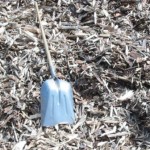 appears in a myriad of species, forms and sizes; it knits together, doesn’t flow well, consolidates and packs easily; it can have a wide range of moisture contents, basic and bulk densities and calorific values; it will freeze; it is very dusty, catches fire easily and is self-combustible; it can contain all manner of contaminants. Conversely, wood pellets are uniform in size and moisture content, are very free flowing, but are quite fragile and easily degrade and require special handling.
appears in a myriad of species, forms and sizes; it knits together, doesn’t flow well, consolidates and packs easily; it can have a wide range of moisture contents, basic and bulk densities and calorific values; it will freeze; it is very dusty, catches fire easily and is self-combustible; it can contain all manner of contaminants. Conversely, wood pellets are uniform in size and moisture content, are very free flowing, but are quite fragile and easily degrade and require special handling.
Increasing numbers of power utilities are eyeing biomass as a source of fuel, primarily as a means of lowering CO2 emissions. New biomass boilers are being constructed but many coal-fired boilers are being converted for co-firing biomass or converted to 100% biomass. Biomass can be introduced into combustors as `hog fuel’, wood pellets or injected as a powder. Working in the forest and converting the wood into usable products is part of the Canadian heritage. There are many people and companies who have extensive experience handling woody biomass in all its myriad of forms. However, with the recent rush to `green energy’ and the identification of woody biomass as a green fuel, there are a lot of interested and well-intentioned but woefully inexperienced people vying for various grants and proposing new projects, but who have little or no experience with biomass.
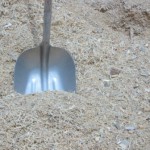 Care must be taken in the design of your biomass handling system whatever the form. The topic of design is as varied and complex as the material and the intent in this article is to cover woody biomass, in the form of hog fuel and pellets, which is utilized as fuel. I will discuss the subject in a broad-brush manner suitable for this publication. Following is a list and short description of things to consider when designing your system.
Care must be taken in the design of your biomass handling system whatever the form. The topic of design is as varied and complex as the material and the intent in this article is to cover woody biomass, in the form of hog fuel and pellets, which is utilized as fuel. I will discuss the subject in a broad-brush manner suitable for this publication. Following is a list and short description of things to consider when designing your system.
A general tendency in most projects is to view the biomass handling system as the least glamorous part of the processing facility and it is the area where most people try to cut costs. In any project it is imperative to minimize costs, but the biomass processing system is not always the best place to do so.
The purpose of a biomass processing and handling system is to produce a boiler feedstock that is consistent in constituents, size and moisture content. Depending upon the variety and form of the raw incoming material, processing systems can be quite complex.
There are many factors that affect the design of the biomass system, including:
Type of facility
The requirements for a facility that generates power for sale and must run 24 hours per day, 350 days per year at >95% uptime are much more rigorous than for a facility that utilizes the energy in-house and doesn’t suffer punitive damages from being off-line. A power producer must guarantee reliability, therefore his fuel handling systems must be reliable and in some cases redundant. Additionally, an independent cogeneration or combined heat and power facility must meet the requirements of both the host company and the power recipient.
Capital Cost
Generally, the cost of the biomass handling system is not a constant percentage of the cost of whole facility; the smaller the size of the whole facility, the greater the percentage of cost of the fuel handling system in relation to the cost of the whole facility. Hence, there is greater pressure to reduce costs and often this results in an inferior biomass handling system.
Location and space
A facility that is located within a city or town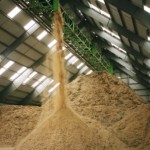 will likely be required to meet stricter environmental conditions than one isolated in the country, possibly including an enclosed biomass handling system and an odour control system.
will likely be required to meet stricter environmental conditions than one isolated in the country, possibly including an enclosed biomass handling system and an odour control system.
Biomass handling and storage requires considerable space. However, biomass-fired facilities are often located adjacent to other existing facilities and space can be at a premium. The available space has a tremendous impact on layout and layout affects process operability and capital cost.
Incoming material
For this article, it is assumed that the incoming material will be pre-processed hog fuel either as residuals from wood products plants or as hogged forest residues; or wood pellets. If possible, establish a hog fuel quality specification with your biomass suppliers; one that will have material, size, moisture content, and contaminant specifications. Establish a fuel sampling process to ensure quality. Wood pellets are usually manufactured to an industry standard. The handling systems for hog fuel and wood pellets would be quite different.
Required Quality of hog fuel
If the quality and form of the incoming material is quite different from that of the required combustor fuel, then suitable processing equipment will be required on site. It is my experience that the quality of incoming material will not always be as specified and you must have the ability to deal with sub-quality material arriving on site, either with equipment or procedures.
Delivery method and timing
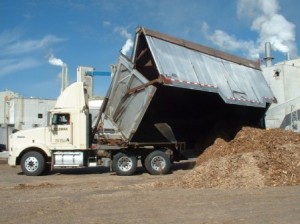 How the material is delivered to the plant site has a big impact on the biomass handling system. The systems required for truck, rail and barge receiving and unloading are each quite different and affect the layout, cost and process.
How the material is delivered to the plant site has a big impact on the biomass handling system. The systems required for truck, rail and barge receiving and unloading are each quite different and affect the layout, cost and process.
Timing of deliveries does as well and the delivery hours per day and days per week must be considered; as do interruptions in supply. If the fibre source is shut down for prolonged periods, you will need more storage. If you have established supply contracts, and your plant is down for a prolonged period, you will need more storage or will need to find another place that can take the material temporarily.
Climate
The biomass handling system for a facility located in northern Canada is much different from one located on the west coast or from one in the southern USA. So, make sure your system designer has the appropriate experience.
Type of project
The type of project can have an impact on the fuel handling system you end up with. An EPC or design / build contractor will want to minimize his costs and often does so in the biomass processing area. To avoid this, hire a competent owner’s engineer with good biomass handling experience to do the conceptual design and write the design / build specification document for your biomass handling system.
Generally, a hog fuel handling system requires the following sub-systems:
Delivery / Receiving System
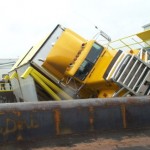 The design of a truck receiving system depends upon the type of truck being used to haul the biomass. Trucks can be self-unloading or non-self unloading. Trucks can vary in size from a single trailer to Super B-Trains. Additionally, trucks tend to come during the daylight hours, so the system must be designed to handle the peak flow.
The design of a truck receiving system depends upon the type of truck being used to haul the biomass. Trucks can be self-unloading or non-self unloading. Trucks can vary in size from a single trailer to Super B-Trains. Additionally, trucks tend to come during the daylight hours, so the system must be designed to handle the peak flow.
A delivery receiving system utilizing self-unloading trucks would include a truck scale, receiving hopper(s) and conveyors. Self-unloading trucks are available as end or side-dumping or with `shuffle floors’. If non-self unloading trucks are utilized, then a truck tipper would be required. There are many configurations and sizes available for end-dumping tippers. A new side-dumping tipper has shown to be very effective at dumping Super B-Trains in extreme cold climates.
Biomass delivery by rail requires a railcar scale, a railcar moving system, an unloading system, receiving hoppers and conveyors to storage. Unloading systems can be as simple as mobile equipment, or can be an end-dumper or for high capacity a roll-over dumper.
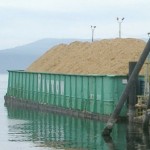 Biomass delivery by barge is popular on the west coast and the equipment utilized varies greatly. The best and most simple system utilizes mobile equipment that drives onto the barge via a ramp. The ramp is equipped with a receiving hopper that the mobile equipment fills. The hopper discharges into the conveyor system to storage. Other systems utilize dockside knuckleboom unloaders or overhead cranes with clamshell buckets. Delivery by barge requires a docking / mooring facility and possibly a warping system, that will accommodate water level changes.
Biomass delivery by barge is popular on the west coast and the equipment utilized varies greatly. The best and most simple system utilizes mobile equipment that drives onto the barge via a ramp. The ramp is equipped with a receiving hopper that the mobile equipment fills. The hopper discharges into the conveyor system to storage. Other systems utilize dockside knuckleboom unloaders or overhead cranes with clamshell buckets. Delivery by barge requires a docking / mooring facility and possibly a warping system, that will accommodate water level changes.
Conveying Systems
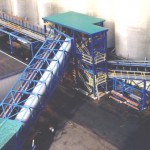 Belt and chain conveyors are most common because of their reliability. Generally, belt conveyors are less costly but require more real estate, due to their lower operating slope; however, belt conveyor slope is greatly reduced in cold climates. Conveyor speed should be kept quite low, less than 400 fpm. And belt loading should also be kept low to allow for oversized material. A belt weigh scale is often included.
Belt and chain conveyors are most common because of their reliability. Generally, belt conveyors are less costly but require more real estate, due to their lower operating slope; however, belt conveyor slope is greatly reduced in cold climates. Conveyor speed should be kept quite low, less than 400 fpm. And belt loading should also be kept low to allow for oversized material. A belt weigh scale is often included.
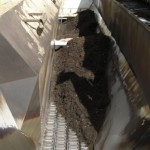 Chain conveyors can operate at steeper slopes and are suitable for shorter or complicated runs. Avoid concave vertical curves. Utilize abrasion resistant wear plates; however, rocks and grit tend to become embedded in UHMW and will wear out chain quickly, so take care where you use it. Chain conveyors are costly, so resist the urge to undersize components to save on cost.
Chain conveyors can operate at steeper slopes and are suitable for shorter or complicated runs. Avoid concave vertical curves. Utilize abrasion resistant wear plates; however, rocks and grit tend to become embedded in UHMW and will wear out chain quickly, so take care where you use it. Chain conveyors are costly, so resist the urge to undersize components to save on cost.
Avoid chute valley angles less than 45°; with some materials and in some conditions, even this is not steep enough.
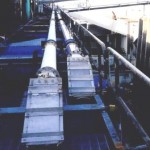 Dilute phase pneumatic conveyors have long been used for transporting hog fuel; they are less costly than belt or chain conveyor systems, but have high power requirements and can generate a lot of fugitive dusting.
Dilute phase pneumatic conveyors have long been used for transporting hog fuel; they are less costly than belt or chain conveyor systems, but have high power requirements and can generate a lot of fugitive dusting.
Screening / Metal Removal System
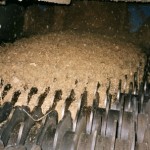 A scalping screen is recommended for removing gross over-sized material, which you can expect to get in your system regardless of the assurances of your biomass supplier. The disc type of screen is best suited to this tough application and is also quite good at removing stones larger than the screen opening. Utilize abrasion resistant steels and don’t undersize the screen.
A scalping screen is recommended for removing gross over-sized material, which you can expect to get in your system regardless of the assurances of your biomass supplier. The disc type of screen is best suited to this tough application and is also quite good at removing stones larger than the screen opening. Utilize abrasion resistant steels and don’t undersize the screen.
Depending upon the quantity of gross over-sized material rejected by the screen, there may or may not be a grinder / hog. If one is required, it is recommended that a solid rotor, high inertia hog be utilized. Additionally, a metal detector belt should be installed before the hog to stop the feed should large pieces of tramp metal be detected.
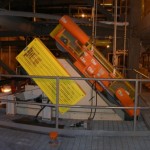 Ferrous metal removal is essential and can be accomplished with a magnet. There are several magnet types and arrangements available, but the primary magnet should be a self-cleaning one. Avoid locating magnets in the cross-belt configuration if possible, as the magnet will have difficulty removing metal which is underneath the load on the belt. Locate the magnet over a pulley transition, where the material is falling and the material is in suspension. If possible locate the magnet after the scalping screen; doing so ensures that gross over-sized material will not become jammed between the magnet and the conveyor.
Ferrous metal removal is essential and can be accomplished with a magnet. There are several magnet types and arrangements available, but the primary magnet should be a self-cleaning one. Avoid locating magnets in the cross-belt configuration if possible, as the magnet will have difficulty removing metal which is underneath the load on the belt. Locate the magnet over a pulley transition, where the material is falling and the material is in suspension. If possible locate the magnet after the scalping screen; doing so ensures that gross over-sized material will not become jammed between the magnet and the conveyor.
Storage and Reclaiming System
The amount of storage required depends upon: a) the minimum amount of material required to maintain reliable operation; b) the longest period of time that the flow of incoming material may be interrupted; and c) the longest amount of time that the plant must continue to receive biomass, when it is not consuming fuel.
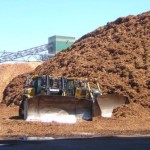 Covered storage is costly and is only necessary in special circumstances such as in certain urban environments that mandate it; or where the biomass is quite dry (<25%) and the climate very wet; or conversely where the material is wet and there is a real possibility of the material freezing into lumps. In most climates and locations, open storage piles are suitable. Dusting issues can be minimized by the use of wind fences.
Covered storage is costly and is only necessary in special circumstances such as in certain urban environments that mandate it; or where the biomass is quite dry (<25%) and the climate very wet; or conversely where the material is wet and there is a real possibility of the material freezing into lumps. In most climates and locations, open storage piles are suitable. Dusting issues can be minimized by the use of wind fences.
Pile building can be accomplished by mobile equipment, over-pile belt or chain conveyors, slewing / luffing stackers, or pneumatic conveyors.
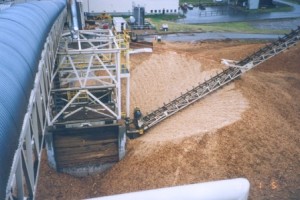 There are many storage and reclaim systems available and each have their place. Choosing the right system depends upon: the material being handled; the amount of storage required; the amount of live-storage required; the need or not for first-in / first-out flow; the ability to accurately meter; the need for mixing; and whether covered storage is required or not.
There are many storage and reclaim systems available and each have their place. Choosing the right system depends upon: the material being handled; the amount of storage required; the amount of live-storage required; the need or not for first-in / first-out flow; the ability to accurately meter; the need for mixing; and whether covered storage is required or not.
I’ve found that fully automatic systems with 100% live-storage are prohibitively costly and most projects that I have been involved in end up with something less, usually with enough live-storage for 2-4 hours of operation with no intervention.
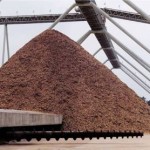 Under-pile chain reclaimers are the lowest cost but have the smallest live-storage and tend to bridge. Ladder-stoker reclaimers have been in use for decades, are quite reliable and have somewhat more live-storage. Depending upon their size, over-pile, rotary chain reclaimers can have live-storage of 12-24 hours, but they are more costly.
Under-pile chain reclaimers are the lowest cost but have the smallest live-storage and tend to bridge. Ladder-stoker reclaimers have been in use for decades, are quite reliable and have somewhat more live-storage. Depending upon their size, over-pile, rotary chain reclaimers can have live-storage of 12-24 hours, but they are more costly.
Under-pile, rotary screw reclaimers work well and do a good job of mixing but are costly. Under-pile, linear screw reclaimers also work well, do a good job of mixing and can have the largest live-storage volume; unfortunately, they are very costly.
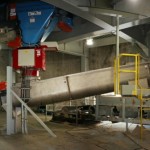 Live-bottom silos are suitable for storing some biomass such as wood chips, sawdust, pellets and shavings but are not recommended for hog fuel that contains a wide variety of sizes and stringy bark.
Live-bottom silos are suitable for storing some biomass such as wood chips, sawdust, pellets and shavings but are not recommended for hog fuel that contains a wide variety of sizes and stringy bark.
Conveying System to Combustor
The conveying system to the combustor should include a weigh scale and a tramp metal magnet. Additionally, a final scalping screen is recommended.
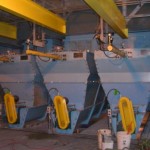 The type, quantity and size of fuel feed bins is usually specified and supplied as part of the combustor package. The conveying system to the combustor should be capable of distributing the hog fuel uniformly so that the fuel bins remain full.
The type, quantity and size of fuel feed bins is usually specified and supplied as part of the combustor package. The conveying system to the combustor should be capable of distributing the hog fuel uniformly so that the fuel bins remain full.
The conveyor system from the reclaimer through to the combustor feed bins should be variable speed and should remain full so as to minimize the lag time between the reclaimer and the fuel feed bins, thereby keeping a near constant level in the fuel bins.
With today’s accurate bin level sensors controlling the feed conveyors to the combustor, it is no longer necessary to overfeed the bins and have a return conveyor system to the storage pile.
Dust Collection Systems
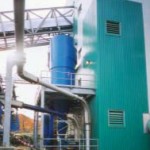 Hog fuel can be quite dusty and you should provide for dust containment, suppression and collection in your design. Depending upon the locale, high efficiency cyclones may suffice, but in others, bag houses will be required. If the dust is sufficiently fine, spark detection, deluge systems and abort gates may be required.
Hog fuel can be quite dusty and you should provide for dust containment, suppression and collection in your design. Depending upon the locale, high efficiency cyclones may suffice, but in others, bag houses will be required. If the dust is sufficiently fine, spark detection, deluge systems and abort gates may be required.
Rock / Sand Removal Systems
Rock and sand removal systems are costly to install and operate and are rarely used. It is far better to prevent the rocks from entering the material flow than it is to remove them afterwards. Consequently, outdoor storage piles should be paved.
Bark Presses / Dryers
In most greenfield cases, it is best to design the combustor to suit the moisture content of the material being utilized as fuel, rather than attempting to dry the biomass. However in some brownfield installations, bark dryers are necessary to reduce the moisture content of the biomass to a range that is compatible with the combustor.
Sometimes on the west coast, biomass is so wet (>60%) that bark presses must be utilized to reduce the moisture content to 55%.
Wood pellets are quite dry (12-15%), are fragile and easily break-up every time they are handled; so a material handling system for wood pellets has special requirements, including keeping them dry. The dust produced by degrading pellets is very fine and is combustible and explosive; therefore dust collection systems with spark detection, deluge systems and abort gates are essential.
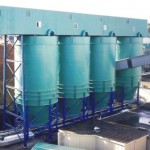 Minimize the number of times the pellets are handled and utilize gentle handling equipment, including: self-unloading, `shuffle-floor’ trucks or bottom dump railcars; `shuffle-floor’ hoppers; conventional belt conveyors or steep angle belt conveyors; silos with gentle loading chute and sloped bottoms to variable opening discharge chutes; belt conveyor(s) to the fuel bins; screw distribution conveyor over the bins; and dust collection systems.
Minimize the number of times the pellets are handled and utilize gentle handling equipment, including: self-unloading, `shuffle-floor’ trucks or bottom dump railcars; `shuffle-floor’ hoppers; conventional belt conveyors or steep angle belt conveyors; silos with gentle loading chute and sloped bottoms to variable opening discharge chutes; belt conveyor(s) to the fuel bins; screw distribution conveyor over the bins; and dust collection systems.
If the wood pellets are being co-fired with pulverized coal, they will also need grinding or pulverizing before injecting into the combustor.
About the Author
Paul Janzé has more than 30 years experience in engineering design, project management, equipment manufacturing and maintenance, primarily in the forest products and energy industries. His material handling experience includes: biomass handling and processing including forest residuals, logs, lumber, chips, woodwaste, straw and poultry litter, sludge and biosolids; municipal solid waste (MSW); and coal and ash handling.
He has a keen interest in technologies which recover and utilize waste materials and convert them into products such as wood pellets. Paul’s specialties are fibre flow analysis and mass balances, process optimization and designing novel solutions to complex processing and handling problems.
For other articles related to biomass processing and handling, go to Paul’s blog at www.advancedbiomass.com
Paul can be reached by email at: pjanze@telus.net

Dear Paul, excellent website, do boom reclaimers work similar to bucket wheel excavators? How many types are there, and what level of spillage loss would you expect from this give the density of wood chips?
Thanks you
Hi Paul,
Thank you for visiting my website.
By boom reclaimers, I am referring to the over-pile chain type of reclaimer, which has a dual strand chain flight conveyor mounted on a long boom . The boom is fixed at a pivot at one end to give a luffing motion, with the main part of the boom suspended above the storage pile. The boom is lowered onto the pile, such that the running flight conveyor drags material down off the surface of the pile. There are three types of over-pile chain reclaimer:
– a) the traversing type that operates along a longitudinal, conical storage pile
– b) the radial type that slews around a radial, conical storage pile
– c) a primitive fixed type that neither luffs or slews
Traversing over-pile chain reclaimers can have one or two booms to reclaim from one or two longitudinal piles. The traversing over-pile chain reclaimer is similar to a bucket wheel excavator in that it travels along a track and reclaims from longitudinal piles. The outstocking function is usually done by a separate traversing, luffing outstocking conveyor.
The radial type of over-pile chain reclaimer is often combined with a slewing and luffing outstocking conveyor and can sometimes have two slewing booms mounted back-to-back on a single supporting tower. The radial type of reclaimer is similar to a bucket wheel excavator only in that it can slew.
Both types of over-pile chain reclaimers are similar to bucket wheel excavators in that they remove material from the top surface of a storage pile. As the chain conveyor is dragging material down the face of the pile, spillage isn’t an issue.
Have I answered your questions O.K.?
I see that you are from the IEA Clean Coal Centre (CCC). Are you involved with projects that convert coal-fired power plants to biomass?
FYI, I am currently involved with the engineering of the material handling system for the conversion of Ontario Power Generation’s, 210 MW power plant in Atikokan, ON to 100% wood pellets.
Let me know if I can be of further assistance.
Paul
Hello Prasanna,
Thank you for visiting my website, http://www.advancedbiomass.com .
Generally, when utilizing biomass for energy, the system that requires the fewest biomass processing steps is the most economic.
Biomass handling systems are often one of the most costly parts of a biomass energy system, particularly if you are receiving the raw material in un-processed form and you have to size-reduce it, screen it, dry it, and store it under cover before metering it to the boiler, combustor or gasifier.
Depending upon the processing steps required, the cost for biomass handling systems becomes a greater percentage of the entire project cost, as the size of the energy plant becomes smaller.
Gasifiers are reported to be more efficient, but when you look at the total system requirements to support a gasifier, then they don’t look so efficient.
If you can get your fuel delivered to the plant free-of-charge and in a ready-to-burn state, you can likely make a 1-5 MW gasification plant, if not profitable, then at least break-even. Or, if the gasification plant is located adjacent to an existing plant and is able to use the same infrastructure, then the plant could be successful.
Without knowing the specifics of your project, I cannot offer much more than these generalizations.
Paul
Very Informative and Interesting.
I have a dust control issue in the storage are used to house the formed wooden pellets after production / before they can be used in the combustion process.
Huge amounts of dust is produced when the pellets crash to the floor from the conveyor from a height of around 4mt, and the conveyor can move in an arc to allow different batches to be stored in different piles until being tested and used.
Have you come across any dust containment system that can capture the dust at source (ie the pile of pellets) before conveying to the bag house ?
You advice would be most gratefully received !
Hello Mr. / Ms. Wells,
I am currently involved in a large pellet handling project in Ontario, where Ontario Power Generation is converting their 210MW coal-fired power plant in Atikokan, ON to 100% wood pellets. We are designing the new wood pellet material handling system, which includes pellet receiving, (2) 5000t storage silos, reclaiming and conveying to the boiler. Pellet breakage is a big concern with 45m high silos; so we have developed a unique way of minimizing fines generation. Additionally, the project includes dust collection systems and spark, fire and explosion detection and suppression.
Before I consider providing assistance, I need to know a bit more about you, including the following:
– the name of your company and contact information
– your position
– a better description of the problem; maybe a general arrangement drawing.
– also a process flow diagram would be helpful
– I don’t understand what you mean by “4mt”; ….4 meters!?! What measurement system are you using?
Paul Janze
Advanced Biomass Consulting Inc.
Langley, BC Canada
Do you have any experience with the use live bottom screw feeders ? Would I be able to get your input concerning handling “dry” chopped corn stover ? Size range is 4″, but with stringers,etc. up to 10″
My customer wants to use a 10′ x 10′ (square) x 15′ tall storage vessel with a full live bottom bank of screws. The live bottom would consist of (8) augers 13″ diameter with variable pitch flights.
Be glad to supply more info if this is something you have experience with
Neal,
Thank you for visiting my website. I hope that you enjoyed the articles and find them useful.
Yes, I have experience with both live-bottom screw feeders and corn stover, which is not an easy material to handle. It is light and stringy, it readily absorbs moisture, it compresses and compacts, it doesn’t flow freely, it is abrasive, it is combustible and the dust it produces can be explosive.
I would be pleased to provide assistance, but before I do, I like to know who I am dealing with, so if you could tell me a bit about yourself and your company, it would be greatly appreciated. Some more information about your particular project would also be helpful.
I look forward to hearing from you.
Paul